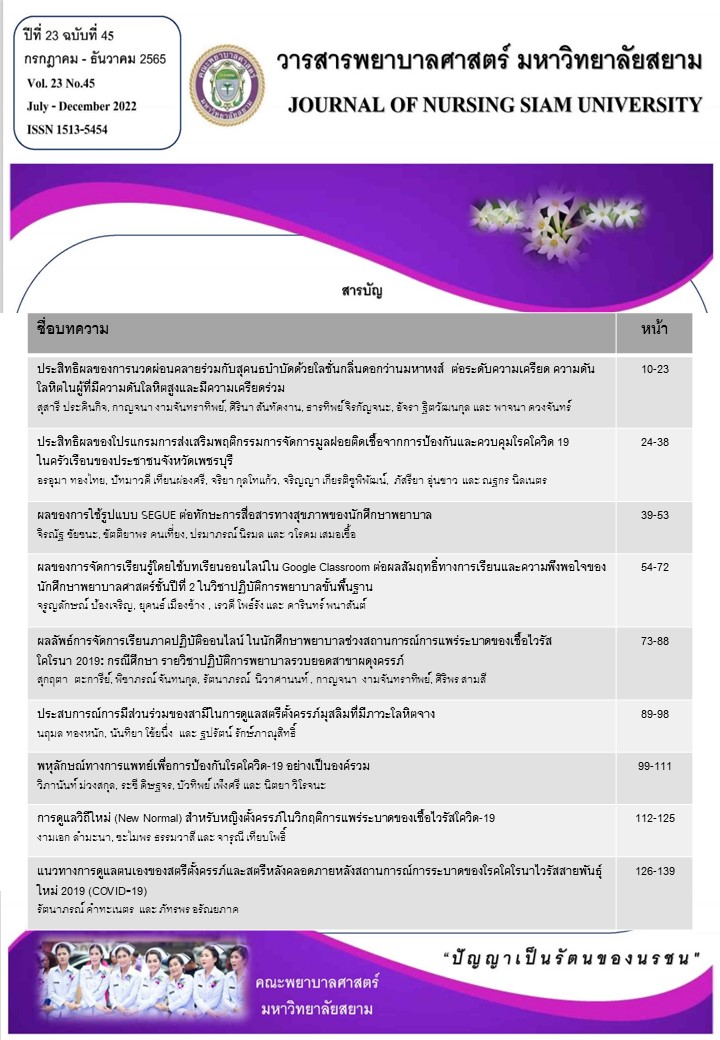The Effects of SEGUE Model on Health Communication Skills among Nursing Students
Keywords:
SEGUE communication, Communication skills, Nursing studentsAbstract
This quasi-experimental study aimed to compare the health communication skill of nursing students in the pre and post-programmed groups, and to compare the health communication skill scores between the group receiving the SEGUE program and the group receiving regular program. The samples were 80 nursing students who are participated in the simulation base learning. Research instruments used were 1) SEGUE communication and 2) Thai Health Communication Assessment Tool (T-HCAT). The content validity was 0.95, the reliability was 0.99. Descriptive statistics and paired t-test were used in control and experimental groups compared between pre and post tests and t-test after the experiment. The results revealed that: 1) After participating in the program, the mean scores of health communication skill of the students who receiving the SEGUE program were significantly higher than before (p <.001). 2) After receiving the program, the mean scores of health communication skill of the students who receiving the SEGUE program were significantly higher than the control group (p <.001).
It can be concluded that the effect of SEGUE program is important to help nursing students to gain the health communication skill and the SEGUE program can also be used to practicing the communication skill in other related fields.
References
กฤดิญาดา เกื้อวงศ์ และอารีย์วรรณ อ่วมตานี. (2563). ประสบการณ์การเป็นพยาบาลจบใหม่ที่ปฏิบัติงาน ในหอผู้ป่วยวิกฤตโรงพยาบาลมหาวิทยาลัยจุฬาลงกรณ์มหาวิทยาลัย. วารสารพยาบาลสภากาชาดไทย, 13 (1), 90-101.
จุไรรัตน์ ดวงจันทร์. (2563). การสื่อสารเพื่อส่งต่อข้อมูลทางการพยาบาลด้วยเทคนิคเอสบาร์. วารสารพยาบาลศาสตร์ มหาวิทยาลัยสยาม, 21(41), 91–103.
นิตยา ศรีญาณลักษณ์. (2557). การบริหารการพยาบาล (พิมพ์ครั้งที่ 5). นนทบุรี: โครงการสวัสดิการวิชาการสถาบันพระบรมราชชนก กระทรวงสาธารณสุข.
มัณฑนา เทพมงคล. (2015). การรับรู้วัฒนธรรมองค์การกับความฉลาดทางอารมณ์ที่พยากรณ์การสื่อสารของพยาบาลและผู้ช่วยพยาบาลกับผู้รับบริการในโรงพยาบาลของรัฐ. รายงานการประชุมวิชาการและนำเสนอผลการวิจัยระดับชาติ และนานาชาติกลุ่มระดับชาติด้านมนุษยศาสตร์และสังคมศาสตร์, 2(6), 387-39
สภาการพยาบาล. (2561). สมรรถนะหลักของผู้สำเร็จการศึกษาระดับปริญญาตรี ปริญญาโท ปริญญาเอก สาขาพยาบาลศาสตร์ หลักสูตร์ฝึกอบรมการพยาบาลขั้นสูงระดับวุฒิบัตรและได้รับวุฒิบัตร/หนังสืออนุมัติแสดงความรู้ความชำนาญเฉพาะทางการพยาบาลและการผดุงครรภ์ และการพยาบาลเฉพาะทางสาขาพยาบาลศาสตร์. สืบค้นเมื่อ 1 กันยายน 2565. จากเว็บไซต์ https://www.tnmc.or.th/images/userfiles/files/9999.pdf
อติญาณ์ ศรเกษตริน, ดาราวรรณ รองเมือง และ รุ่งนภา จันทรา. (2562). การศึกษาพยาบาลในศตวรรษที่ 21: สมรรถนะและบทบาทของอาจารย์พยาบาล. วารสารพยาบาลทหารบก, 20(1), 12-20.
Brown, M. T., Bussell, J., Dutta, S., Davis, K., Strong, S., & Mathew, S. (2016). Medication adherence: truth and consequences. The American journal of the medical sciences, 351(4), 387-399.
Chen, A. M., Kiersma, M. E., Keib, C. N., & Cailor, S. (2015). Fostering interdisciplinary communication between pharmacy and nursing students. American Journal of Pharmaceutical Education, 79(6).
Grant, M. S., & Jenkins, L. S. (2014). Communication education for pre-licensure nursing students: literature review 2002–2013. Nurse education today, 34(11), 1375-1381.
Mahmood, L. S., Mohammed, C. A., & Gilbert, J. H. (2021). Interprofessional simulation education to enhance teamwork and communication skills among medical and nursing undergraduates using the TeamSTEPPS® framework. medical journal armed forces india, 77, 42-48.
Makoul, G., & Schofield, T. (1999). Communication teaching and assessment in medical education: an international consensus statement. Netherlands Institute of Primary Health Care. Patient education and counseling, 37(2), 191–195.
Makoul, G. (2001). The SEGUE Framework for teaching and assessing communication skills. Patient education and counseling, 45(1), 23–34.
Maureen Judd. (2013). Broken communication in nursing can kill : teaching communication is vital. Creative nursing, 19(2), 101–104.
Oliveira, K. R. E. D., & Braga, E. M. (2016). The development of communication skills and the teacher’s performance in the nursing student’s perspective. Revista da Escola de Enfermagem da USP, 50, 32-38.
Ross, J. (2018). Effective communication improves patient safety. Journal of PeriAnesthesia Nursing, 33(2), 223-225.
Shafakhah, M., Zarshenas, L., Sharif, F., & Sabet Sarvestani, R. (2015). Evaluation of nursing students' communication abilities in clinical courses in hospitals. Global journal of health science, 7(4), 323–328.
Skillings, J. L., Porcerelli, J. H., & Markova, T. (2010). Contextualizing SEGUE: Evaluating Residents' Communication Skills Within the Framework of a Structured Medical Interview. Journal of graduate medical education, 2(1), 102–107. https://doi.org/10.4300/JGME-D-09-00030.1
Son, H. K., & Hee Kim, D. (2019). Effect of SEGUE-based communication education on nursing simulation practice: a quasi-experimental design. Contemporary nurse, 55(4-5), 330–340.
Downloads
Published
How to Cite
Issue
Section
License
Copyright (c) 2022 Journal of Nursing, Siam University

This work is licensed under a Creative Commons Attribution-NonCommercial-NoDerivatives 4.0 International License.
Content and information published in the Journal of Nursing, Siam University is the comment and responsibility of the authors.
Articles, information, images, etc. published in the Journal of Nursing. Siam University is the copyright of the Journal of Nursing, Siam University. If any person or entity wants to take all or part of it for publication for any purposes, please reference the Journal of Nursing, Siam University.



